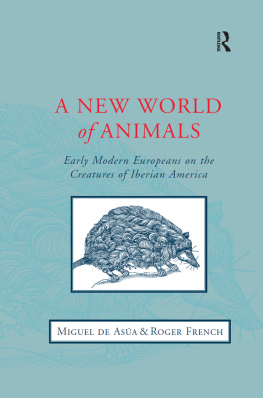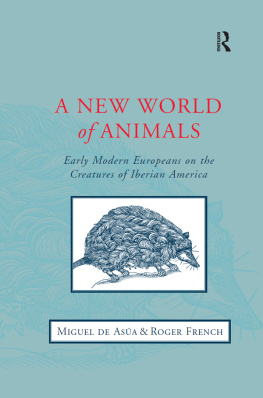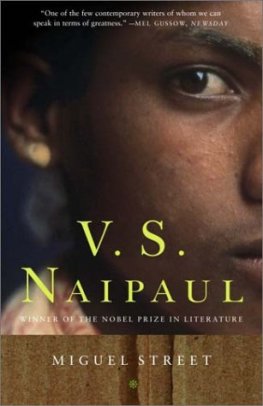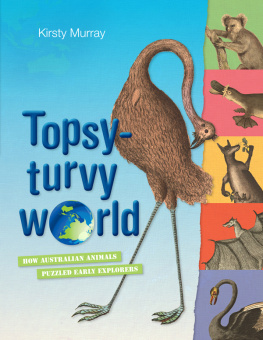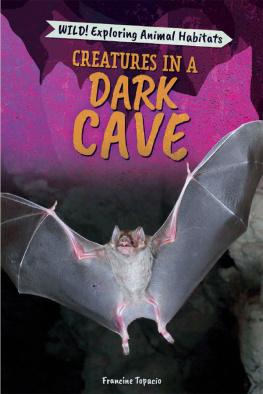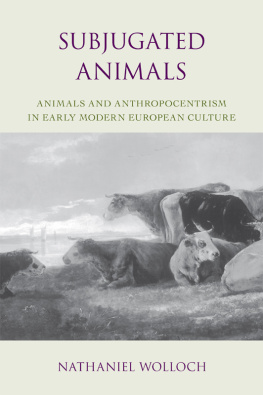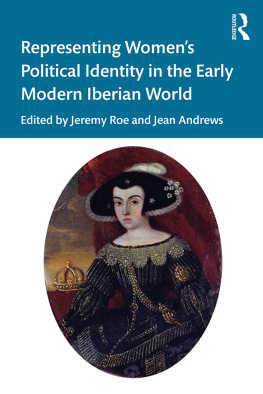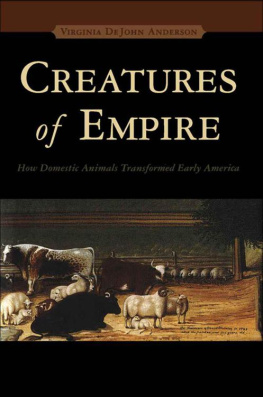
A NEW WORLD OF ANIMALS
A New World of Animals
Early Modern Europeans on the Creatures
of Iberian America
MIGUEL de ASA and ROGER FRENCH

First published 2005 by Ashgate Publishing
Published 2016 by Routledge
2 Park Square, Milton Park, Abingdon, Oxon OX14 4RN
711 Third Avenue, New York, NY 10017, USA
Routledge is an imprint of the Taylor & Francis Group, an informa business
Copyright 2005 Miguel de Asa and Roger French
Miguel de Asa and Roger French have asserted their moral right under the Copyright, Designs and Patents Act, 1988, to be identified as the author of this work.
All rights reserved. No part of this book may be reprinted or reproduced or utilised in any form or by any electronic, mechanical, or other means, now known or hereafter invented, including photocopying and recording, or in any information storage or retrieval system, without permission in writing from the publishers.
Notice:
Product or corporate names may be trademarks or registered trademarks, and are used only for identification and explanation without intent to infringe.
British Library Cataloguing in Publication Data
Asa, Miguel de
A New World of Animals: Early Modern Europeans on the Creatures of Iberian America
1. Animals Latin America History. 2. Latin America Discovery and exploration. I. Title.
II. French, Roger
591.98
Library of Congress Cataloging-in-Publication Data
Asa, Miguel de
A New World of Animals: Early Modern Europeans on the Creatures of Iberian America /
Miguel de Asa and Roger French
p. cm.
Includes bibliographical references and index.
1. Animals Latin America History. I. French, Roger. II. Title.
QL223.A88 2005
591.98dc22
2005000466
ISBN 9780754607793 (hbk)
Typeset by IML Typographers, Birkenhead, Merseyside
Contents
Maps
Black & White Illustrations
The story of the writing of this book has been long and, in the end, sorrowful. It began when in 1998 Roger French and I embarked on a three-year joint project financed by a grant for collaborative research awarded to us by The British Council and Fundacin Antorchas (Argentina) on a competitive basis. This allowed me to spend four successive Michaelmas terms at Cambridge. In 2000 I stayed as a visiting fellow at Clare Hall, and returned in 2001 and 2002 as a visiting member, always enjoying its wonderful facilities, the kind hospitality of the fellows and the competent service of the secretaries and personnel, for which I remain extremely grateful. I was also accepted as a visiting fellow in the Department of History and Philosophy of Science on two of these occasions (1999 and 2000), receiving an equally warm welcome. The research leading to this book was done mostly at the Cambridge University Library and the Whipple Library. I wish to acknowledge the courteous, patient and efficient help of all the librarians, particularly those at the Rare Books Room. They graciously tolerated my hectic pace of research and urgent demand of books. My work at home was backed by the Consejo Nacional de Investigaciones Cientficas y Tcnicas (CONICET). I also wish to express my gratitude to the Dean of the Graduate School of Universidad Nacional de San Martn for granting me the necessary leave permits for travelling. Fundacin Antorchas was generous enough to finance the fourth visit and also provided extra money for the bibliography.
The opportunity of working with Roger French has been a cherished privilege. His outstanding talents as a scholar were beautifully matched by his human virtues, his generosity, his natural kindness. Many times we met at Clare Hall or at his office to discuss the plan, scope and progress of the research, and his insights were invaluable for defining and focusing what were at the beginning only some loose ideas. The sad news of his untimely death in May 2003 reached me when I was in Buenos Aires. By that time I had completed a basic manuscript, which he carefully reviewed and annotated. We had already signed an agreement for publication with Ashgate, and the editor, John Smedley, thought it was worthwhile to carry on the book to completion. Anne, Rogers wife, kindly agreed to send back the manuscript, which I used as a basis for the writing of the definitive version. The editorial assistance given by Ashgate has been invaluable. At every moment John supported me and took special care at each stage of the editing process.
I hope this work will be understood as an honest and sincere tribute to Roger and the open and friendly spirit with which he used to welcome people from foreign parts. All the merits of the book are his and to me are attributable any shortcomings the reader may find in it. The last acknowledgement is due to my wife Mara Natividad and our sons Ignacio and Javier. They shared the days of toil and worry, the many travels and other undeserved inconveniences. For all that I warmly thank them.
Miguel de Asa
It would be difficult to overstate the historical importance of the expansion of Europe into America. Much has been written by historians on the cultural, economic and political consequences of the phenomenon. This book treads a middle road, that of the fluid interface between the cultural and the natural dimensions of the encounter. The subject of our inquiry is an aspect of the discovery of the New World that has been largely ignored: the newness of its animals.
Our story is not concerned with the zoological identification of species seen by Europeans for the first time; it is a story of the encounter between early modern Europeans and the so far unknown animals of the New World, about the ways these were perceived, interpreted, imagined and assimilated. Conceptual patterns that had taken centuries to develop were faced with a huge conundrum. The discovery of a New World shattered the European world-picture and challenged pre-modern moulds of thought. The age of discovery was an age of conquest, of colonization, of mission, of bloodshed and amazement. The European powers set out to complete the settlement and exploitation of the recently discovered lands, and in the wake of this race for new sources of wealth and markets they had to cope with an alien and disturbing reality. True, the most profound and puzzling encounter was that between Renaissance Europe and the native peoples and major Indian cultures of America, enacted as a clash of civilizations, certainly one of the main events in the course of world history. But on the other hand, there was also the meeting with the natural world of America. A New World meant an exotic nature, new landscapes, new minerals, new plants and new animals.
Animals, of course, have always been a prominent element in civilization, an unavoidable presence in the human world. The Western tradition of learning had often raised questions about these sentient beings and instituted inquiries to name them and make an inventory of their dazzling variety. Two main approaches to the animal world can be distinguished in the European tradition of learning. Aristotle, in his treatises on animals, tried to understand them in terms of his natural philosophy, which purported to explain the natures of natural beings and spell out the causes which made them what they were. In the second place Pliny, working at the height of Roman expansion, made an attempt to compile a catalogue of all nature, a project embodied in his
Next page
